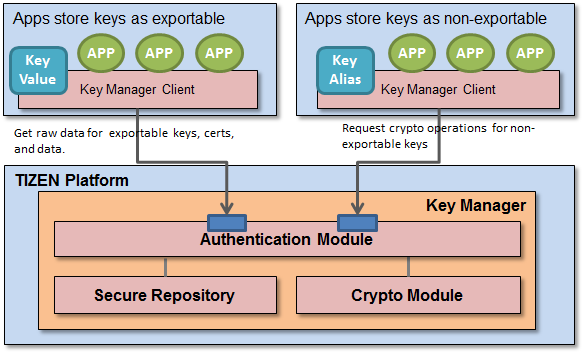|
Tizen Native API
|
The key manager provides a secure repository protected by a user’s passwords for keys, certificates, and sensitive data of users and/or their APPs. Additionally, the key manager provides secure cryptographic operations for non-exportable keys without revealing key values to clients.
Overview
| API | Description |
|---|---|
| Key Manager Client | Provides APIs for accessing the secure repository and additional secure cryptographic operations. |
| Key Manager Data Types | Defines data types used in these APIs and provides utility methods handling them. |
It provides a secure repository for keys, certificates, and sensitive data of users and/or their APPs which are protected by a user’s passwords. Additionally, it provides secure cryptographic operations for non-exportable keys without revealing key values to clients.

The key manager provides 2 types of API.
- secure repository APIs : These APIs provides storing, retrieving, and removing functions for keys, certificates, and data.
- secure crypto APIs : These APIs provides additional cryptographic operations (create asymmetric key pair, sign/verify signature, verify certificate).
Data Store Policy: A client can specify simple access rules when storing a data in Key Manager.
- Exportable/Non-Exportable: Only for data tagged as exportable, Key Manager returns the raw value of the data. If data is tagged as non-exportable, Key Manager does not return its raw value. In that case, Key Manager provides secure cryptographic operations for non-exportable keys without revealing key values to clients.
- Per Key Password: All data in Key Manager is protected by a user’s password. Besides, a client can encrypt its data using its own password additionally. If a client provides a password when storing a data, the data will be encrypted with the password. This password should be provided when get the data from Key Manager.
User Login/Logout and Data Protection
- When a user logs in, logs out or changes his/her password, Key Manager should know about it. Privileged APPs such as LockScreen APP or Setting APP can notify the key manager using these control APIs.
- When a user logs in, the key manager decrypts the user's DKEK (with which a user's data file is encrypted) with a user password. So during the login period, any client can access its data which is protected by a user's password. "user key" in API means DKEK.
- When a user logs out, the key manager removes the user's DKEK from memory. Therefore, clients cannot access any data.
- When a user changes his/her password, the key manager re-encrypts the user's DKEK with the new password.
Data Access Control
- By default, only the owner of a data can access to the data.
- If the owner grants the access to other applications, those applications can read or delete the data from key-manager DB.
- When an application is deleted, the data and access control information granted by the application are also removed.
Alias Format
- The format of alias is "package_id name".
- If package_id is not provided by a client, the key-manager will add the package_id of the client to the name internally.
- Alias should not include whitespace except the case of using as delimiter between package_id and name.
- If the client use "package_id name" format of alias when saving something in key-manager, the client should use package_id of the client itself. If the client doesn't, key-manager will return error code related to input parameter error.
- A client should specify the package id of the owner in the alias to retrieve a a key, certificate, or data shared by other applications.
- Aliases are returned as the format of "package_id name" from the key-manager.